Ford F-150
Rear Brake Pads Replacement Guide
How to change the rear disc brake pads on
a 12th generation 2009-2014 Ford F150 truck with photo illustrated steps.
By Paul B. Michaels Author & Photographer Auto Mechanic Since 1989 |
||
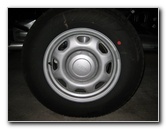 F-150 Rear Wheel |
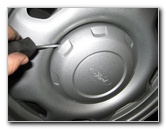 Pry Off Lug Nut Cover |
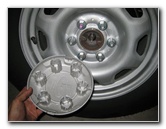 Hub Cap Removed |
| This
automotive "how-to" guide was specifically written to assist owners
of the 12th generation (2009, 2010, 2011, 2012, 2013 & 2014) Ford F-150 truck
in changing the rear disc brake pads. Owners of other F-Series trucks or other Ford, Lincoln and Mercury vehicles such as the Super Duty F-250, F-350, F-450, Expedition, Explorer, Edge, Escape, E-150, E-250, E-350, Transit Connect, Flex, MKX, MKT, Navigator and Mountaineer may also find these DIY rear brake job instructions to be helpful. The tools needed to complete this procedure include a flathead screwdriver, a lug nut wrench, a floor jack, two jack stands, a 13mm socket with a 3/8" ratchet, a "C" or "F" clamp, a new set of rear brake pads and a packet of brake caliper lubricant. A few compatible aftermarket brake pads with their part numbers are as follow: Motorcraft BRF-1425, KFE KFE1602-104, Wagner QC1602, Wagner ZD1602, TRW TPC1602, Raybestos ATD1602C, ACDelco 17D1602CH, Akebono ProACT ACT1602, Power Stop (16-1602) Z16, Akebono ASP1602, Bendix D1602, Monroe CX1602, Bosch BE1602H, Dura International BP1602C and Bosch BE1602. |
||
|
|
||
Please verify the correct replacement part numbers for your F-150 by checking the Amazon Part Finder website. The correct parts may vary depending on the model year, trim level and whether it has the 4WD (four wheel drive) or RWD (rear wheel drive) transmission. |
||
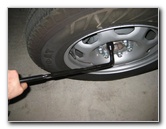 Loosen 6 Lug Nuts |
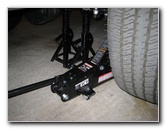 Raise Rear of Truck |
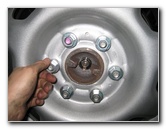 Spin Off 6 Lug Nuts |
| The first two steps
are to park the truck on a level surface and chock the front wheels to
prevent the vehicle from moving. If your F150 is equipped with lug nut covers, gently pry off the cap with a flathead screwdriver to expose the 6 lug nuts. Slightly loosen the 6 lug nuts with the tire iron. Raise the rear of the truck with the floor jack and securely support it with at least two jack stands. I prefer to work on one side of the vehicle at a time for extra safety. |
||
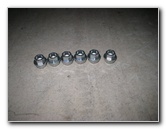 Six Lug Nuts Removed |
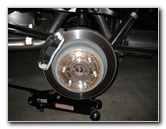 Rear Caliper, Bracket, Rotor |
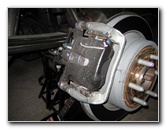 Rear Brake Caliper |
| Spin off the six
lug nuts and set them aside in a safe place. Pull off the rear wheel to expose the rear brake caliper, bracket, rotor and suspension. |
||
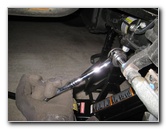 Loosen Lower 13mm Bolt |
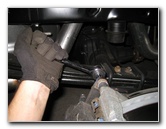 Loosen Upper Caliper Bolt |
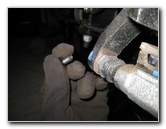 Remove Caliper Bolt |
| The rear brake
caliper is held in place to the bracket by two 13mm bolts located on the
back side of the caliper. Loosen the two caliper bolts by turning them clockwise (as seen from the outside of the vehicle) with the 13mm socket and ratcheting wrench. |
||
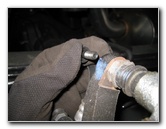 Remove Upper Bolt |
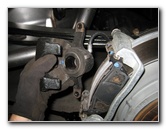 Pull Off Brake Caliper |
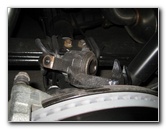 Rest Caliper On Suspension |
| Remove the two
caliper bolts and set them aside with the lug nuts. Carefully pull the rear brake caliper out of the bracket and off the old pads. Securely rest the caliper on the suspension or suspend it from the spring with a bungee cord or piece of rope. |
||
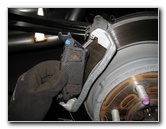 Remove Old Outer Pad |
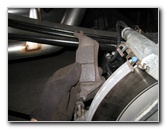 Pull Out Inner Pad |
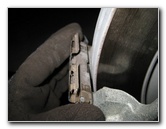 Replace Anti-Rattle Clips |
| Pull the old inner
and outer brake pads out of the caliper bracket. If your new set of rear brake pads came with new metal pad abutment or "anti-rattle" clips, pull the olds one out of the top and bottom of the bracket before installing the new ones. Thoroughly clean off the brake rotor, caliper bracket, brake caliper assembly and the lug nut studs with brake parts cleaner spray. Do not use compressed air or blow with your mouth to clean off the brake parts since breathing in brake dust can be harmful to your health. Brake dust can be carcinogenic (cancer causing) if inhaled.
To remove the existing rotors and install new ones, just remove the two bolts on the rear of the caliper bracket that attach it to the steering knuckle. Then loosen the old rotor with a rubber mallet, pull it off, and slide the new one in its place. |
||
|
|
||
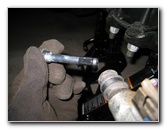 Remove Caliper Pins |
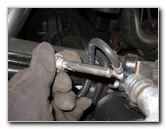 Lubricate & Replace Pins |
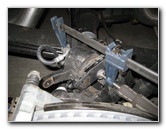 Attach "F" Clamp |
| In order for the
brake caliper to work properly, the two caliper slider pins need to be well
lubricated. Gently pull each caliper slider pin out of its rubber dust boot and apply a thin layer of brake caliper grease. Push the caliper slider pins back in place until the rubber dust boot snaps in place over the metal lip. |
||
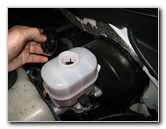 Remove Brake Fluid Cap |
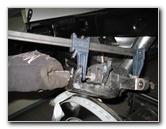 Compress Caliper Piston |
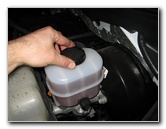 Replace Brake Fluid Cap |
| In order for the
brake caliper to fit over the thicker new brake pads, the caliper piston
needs to be compressed backwards. Attach the "F" clamp to the caliper piston using the back of an old brake pad to evenly distribute the force. Move to the engine bay and twist off the brake fluid reservoir cap in the counter clockwise direction. Removing the brake fluid reservoir cap will allow the brake fluid to more easily travel backwards through the system when you compress the piston. Slowly compress the caliper piston back until it is flush with its rubber dust boot. Try to avoid pinching or otherwise damaging the rubber dust boot. Replace the brake fluid reservoir cap as soon as possible since brake fluid is hygroscopic (absorbs moisture). |
||
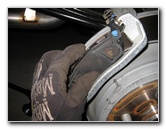 Install New Outer Pad |
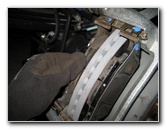 Install New Inner Pad |
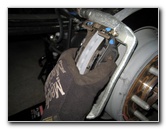 Push Pads Against Rotor |
| Install the new
brake pads in to the bracket and push them together flush against the rotor. Apply a thin layer of brake caliper grease to any place where metal to metal contact takes place such as the outer rings of the caliper piston. Do not apply lubricant to the friction surface of the new pads. |
||
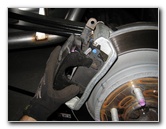 Replace Rear Caliper |
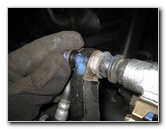 Thread In Upper Caliper Bolt |
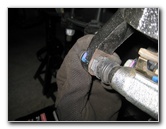 Insert Lower 13mm Bolt |
| Lower the rear
caliper over the new pads and in to the bracket.
If the caliper won't fit over the new pads, you may need to compress the caliper piston back a bit further. Spin in the two caliper bolts by hand a few turns to prevent them from becoming cross threaded. |
||
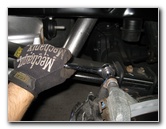 Tighten Upper Caliper Bolt |
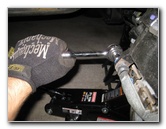 Tighten Lower 13mm Bolt |
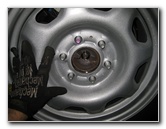 Replace Rear Wheel |
| Tighten the two
13mm caliper bolts by turning them counter clockwise (as seen from outside
of the vehicle) to just past hand tight or about 25 ft lbs of torque. The torque specification in the service manual for the 13mm rear brake caliper bolts is 24 lb-ft (or 32 N*m). Double check that both caliper bolts are tight before moving on to the next steps. If your brake pedal previously felt soft or spongy, the brake fluid may be contaminated with water or the brake lines may contain some air bubbles. It would be best to bleed the brake lines at this time in order to flush out the old fluid and replace it with fresh DOT3 brake fluid. For more on this topic, check out my Brake Line Fluid Bleeding With An Assistant DIY Guide or alternatively the Brake Line Fluid Bleeding With A Power Bleeder Guide. |
||
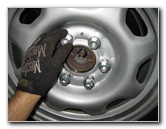 Spin On 6 Lug Nuts |
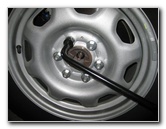 Slightly Tighten Lug Nuts |
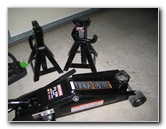 Lower Vehicle With Jack |
| Replace the rear
wheel and spin on the 6 lug nuts by hand to prevent them from becoming cross
threaded. Slightly tighten the lug nuts with the tire iron. Lower the truck from the jack stands using the floor jack until the rear wheel holds enough weight to keep it from spinning. |
||
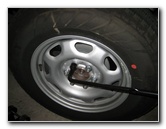 Torque Lug Nuts |
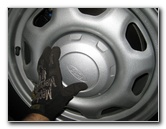 Replace Center Cap |
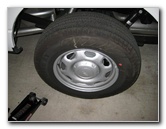 Rear Brake Pads Replaced |
|
Progressively tighten the 6 lug nuts in a "criss cross" or "star" pattern to about 1/4 to 1/3 turn past hand tight. It would be best to use a torque wrench or an impact wrench with a torque stick to tighten the lug nuts to about 150 lb-ft (or 200 N*m) of torque. Sit in the driver's seat of the vehicle and pump the brake pedal a few times to restore the brake line pressure. Check the brake fluid in the reservoir and verify that it is at the proper level. If it is low, add some DOT 3 fluid. Take the truck for a quick test drive and then double check that the lug nuts are properly tightened. To break in your new rear brake pads, just drive normally for the first several hundred miles while trying to avoid any hard or "panic" stops which may glaze over the new pads and cause them to be noisy and/or not perform as well. It's also a good idea to regularly check your driveway for drops of brake fluid which may indicate a leak, check the brake fluid level in the reservoir, and also verify that the lug nuts are still tight. For more,
check out my other
Ford F-150 Repair & Maintenance Guides. |
||
| If you found this guide to be helpful,
please consider making a small donation by clicking on the PayPal.com
"Donate" button located to the right of this paragraph. Thank you!
(Note: I am not a registered charity. Donations are not tax deductible.) |

